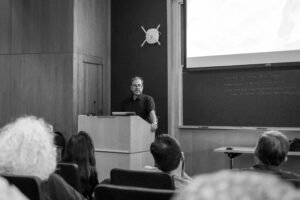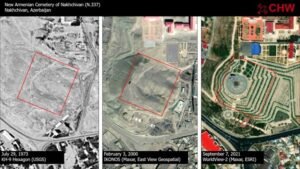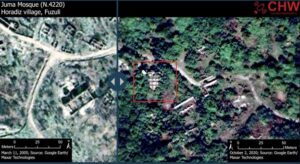
How can one document the destruction of cultural heritage when there’s limited access to the sites themselves? With yet another piece of historic Armenian land lost to the authoritarian Azerbaijani regime, this question is on many Armenians’ minds. By using a combination of satellite imagery and open source materials (photographs and videos available to the public), the team at Caucasus Heritage Watch (CHW) has successfully monitored the status of hundreds of cultural sites without the need to visit the spaces themselves.
CHW is a research program led by archaeologists at Cornell and Purdue Universities. On October 5, team members Dr. Lori Khatchadourian, Dr. Adam T. Smith, Dr. Ian Lindsay and Dr. Husik Ghulyan visited Harvard University to present their findings in Artsakh and discuss their process. Their research site is made available to the public and constantly updated, and their work has been cited in articles by the BBC, Hyperallergic and Eurasianet, among other publications.

Dr. Khatchadourian began the talk by introducing heritage forensics and the way it brings together archaeology, politics, law and cultural aerospace. She noted the work of Argam Aivazian, the Armenian behind the world’s most complete documentation of cultural erasure to date, whose photographs helped prove the cultural genocide in Nakhichevan. Cemeteries like that of Julfa, which was among the sites Aivazian documented, are commonly targeted to remove not only physical objects that connect the Armenians to the land, but also their ancestors, negating social connections of past and present.

Efforts that collect evidence of the existence and destruction of heritage sites—such as Aivazian’s photos and the satellite imagery research of CHW—are especially important when the Azerbaijani government consistently rejects any accusations of erasing traces of Armenian historical presence. For years, Azerbaijan has employed a series of tactics to avoid blame, such as obstructing access and preventing visits by organizations like UNESCO, falsifying history through the outright denial of the existence of Armenians living on the land, or intimidating and suppressing critics like Akram Aylisli.
To combat this racism, the CHW team has monitored Armenian cultural heritage sites in Artsakh to reveal the truth. CHW has geo-located and assessed 110 Armenian cultural sites, finding that 108 of them have been completely eradicated. In five of those cases, Azerbaijan created new symbolic monuments (such as a “Museum of the National Flag”) in an attempt to override the existence of any Armenian history—or, as Dr. Khatchadourian put it, to “drown out the ghosts of the past.” She noted that even remote sites that were already in ruins were targeted and eradicated, a sign of Azerbaijan’s bureaucratic rigor in removing all Armenian heritage on lands under its control.
Conversely, the 109 Azerbaijani heritage sites on the lands that Armenians controlled in Artsakh between 1994-2020 assessed by the CHW team did not face the same systematic destruction, with 42 remaining unchanged and only 16 destroyed. Further, CHW fact checked well-circulated Azerbaijani claims to destruction of cultural heritage (for example, the claim that 63 of the 65 mosques on Armenian land have been destroyed is false). In some cases, like that of the Juma Mosque, the CHW team used Azeri official sources to verify that the mosque’s minaret had not been damaged by the Armenians but, in fact, that its construction had never even been completed in the first place.
Since the Second Artsakh War in 2020, the CHW team has been monitoring 270 at-risk sites and has released threat alerts to draw attention to those at highest risk. However, there is a lag in obtaining the satellite imagery, and the process requires human inspection and critical analysis of the site (for example, finding additional video and photography sources to help confirm the state of a site), which means preservation and prevention can be difficult. Nevertheless, the team continues to make their research available to the public, in hopes of deterring attacks and combating hate.
Their work has already been used to support a court case brought to the International Court of Justice (ICJ) in December of 2021, when the court ruled that Azerbaijan must “take all necessary measures to prevent and punish acts of vandalism and desecration affecting Armenian cultural heritage.” As of now, there is not yet a way for the ICJ to enforce punishment or ensure the Azerbaijani government obeys the ruling. However, there are instances of reparations and accountability in other cases; for example, in 2016 Ahmad Al Faqi Al Mahdi was sentenced to nine years in prison after the International Criminal Court (ICC) found him guilty of attacking historic buildings in Timbuktu, Mali. Additionally, he was ordered to pay 2.7 million euros in reparations to the victims, including the community of Timbuktu, the people of Mali and the international community that rallied around the reconstruction.
With the new loss of Armenian land in 2023, there will be a lot more monitoring work for CHW; the team noted there are 450 heritage sites in all of Artsakh. While raising funds to ensure their work can continue is essential, the team also shared the importance of contacting congressional representatives to raise awareness about the ways in which CHW both helps U.S. foreign policy and provides useful objective data and evidence for decision makers.




This is critical and important work that deserves support.